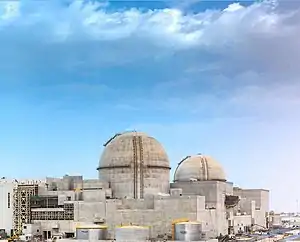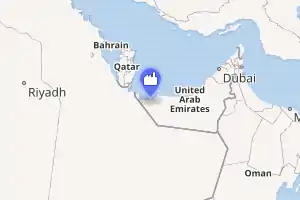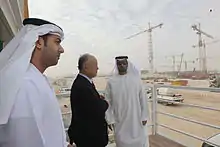Barakah nuclear power plant
The Barakah nuclear power plant (Arabic: محطة براكة للطاقة النووية) is the United Arab Emirates's first nuclear power station, the first nuclear power station in the Arabian Peninsula, and the first commercial nuclear power station in the Arab World. It consists of four APR-1400 nuclear reactors (one operating, three mostly completed). Total capacity is 5,600 MW[1] which is intended to supply up to 25% of UAE's energy needs.[2][3] The site is in the Gharbiya region of Abu Dhabi, on the coastline between the Persian Gulf and the E11 highway, 50 km west of Ruwais.
| Barakah Nuclear Power Plant | |
|---|---|
 Barakah nuclear power plant | |

| |
| Official name | محطة براكة للطاقة النووية |
| Country | United Arab Emirates |
| Location | Approx. 50 km west of Ruwais |
| Coordinates | 23°58′04″N 52°13′54″E |
| Status | Under construction |
| Construction began | Unit 1: 19 July 2012 Unit 2: 16 April 2013 Unit 3: 24 September 2014 Unit 4: 30 July 2015 |
| Commission date |
|
| Construction cost | $24.4 billion USD |
| Owner(s) | ENEC |
| Nuclear power station | |
| Reactor type | PWR |
| Reactor supplier | KEPCO |
| Cooling source | Persian Gulf |
| Thermal capacity | 4 × 3983 MWth |
| Power generation | |
| Make and model | APR-1400 |
| Units under const. | 4 × 1345 MW |
| Nameplate capacity | 5380 MW (after completion) |
| External links | |
| Commons | Related media on Commons |
History

In December 2009, Emirates Nuclear Energy Corporation (ENEC) awarded a coalition led by Korea Electric Power Corporation (KEPCO) a $20 billion bid to build the first nuclear power plant in the UAE. Barakah was chosen as the site to build four APR-1400 nuclear reactors successively, with the first scheduled to start supplying electricity in 2017.[4][5][6]
The plant's ground-breaking ceremony was held on 14 March 2011, including Korean President Lee Myung-bak.[7] Construction of the first unit was begun in the afternoon of 18 July 2012,[8][9] ahead of its scheduled date in late 2012. This happened despite delays being mooted in the wake of the Fukushima Daiichi nuclear disaster.[10] In May 2013, construction started on the second unit, which was then expected to take five years.[11] The first safety-related concrete was poured for Unit 3 in September 2014.[12] Unit 4 started construction in September 2015.[1][13]
In 2011, Bloomberg reported that following detailed finance agreements, the build cost was put at $30 billion: $10 billion equity, $10 billion export-credit agency debt, and $10 billion from bank and sovereign debt. South Korea may earn a further $20 billion from operation, maintenance and fuel supply contracts.[14] A later Bloomberg report indicates the price as $25 billion.[15]
In 2014, the Barakah 1 reactor vessel was delivered onsite and site preparation works for Barakah 3 and 4 started.[16][17] Meanwhile, the concrete-and-steel reactor containment building for Barakah 1 was completed in January 2015.[1]
In March 2015, ENEC applied to Federal Authority for Nuclear Regulation (FANR) for operating licences for Units 1 and 2. [18]
In September 2015, first concrete was poured for Unit 4. More than 18,000 staff were then working on the construction of all 4 units.[19]
In December 2017, the rebel Houthis group claimed to have fired a cruise missile in the direction of the Barakah plant, but the Emirati authorities said that no missiles had actually reached the UAE.[20]
As of 22 March 2018, the project's total cost was refined to $24.4 billion to complete. Startup of Unit 1 was delayed to late 2018.[21]
In December 2018, it was reported that voids were found in the concrete containment buildings for units 2 & 3. Grease was found to have leaked through the unit 3 containment, which may have been due to a crack in the concrete.[22]
Unit 1 was declared complete in 2018. However it was not expected to begin operations until late 2019 or early 2020.[23] In January 2020 it was announced that fuel loading would commence that quarter, about 2.5 years later than the original planned date of August 2017. FANR had raised 400 adverse findings in a review requiring rectification of various technical, organisational and management issues.[24]
In March 2020, ENEC announced the completion of the fuel assemblies loading into the Unit 1 reactor.[25] The reactor started generating electricity in August 2020.[26]
| Unit | Type | Construction start | Commercial operation (scheduled) | Notes |
|---|---|---|---|---|
| Barakah 1 | APR-1400 | 19 July 2012 | 2020 | [6][27][28][29] |
| Barakah 2 | APR-1400 | 16 April 2013 | 2020 | [30][29] |
| Barakah 3 | APR-1400 | 24 September 2014 | 2020 | [31][29] |
| Barakah 4 | APR-1400 | 30 July 2015 | 2021 | [32][29] |
Construction
- Unit 1 is 100% complete as of December 2018.[33]
- Unit 2 is 100% complete as of July 2020. [2]
- Unit 3 is 92% complete as of July 2020, and cold hydrostatic testing was undertaken.[34][2]
- Unit 4 is 85% complete as of July 2020.[2]
Overall construction completion rate for the entire plant is at 94%, as of July 2020.[2]
Nuclear fission was started in Unit 1 in July 2020 achieving the state of criticality on 1 August 2020.[3]
Criticism
In March 2019, Qatar lodged a letter of complaint to the International Atomic Energy Agency (IAEA) regarding the Barakah nuclear power plant, stating concerns about its safety and lack of co-operation with regional states on the project as well as that it poses a serious threat to regional stability and the environment.[35] The UAE denied that there are safety issues with the plant stating that Barakah adheres to the highest standards of nuclear safety and security.[36]
See also
References
- "Barakah Nuclear Power Plant, Abu Dhabi, United Arab Emirates". power-technology. 2015. Retrieved 1 August 2015.
- "UAE completes construction of Barakah 2". World Nuclear News. Retrieved 22 July 2020.
- "Barakah: UAE starts up Arab world's first nuclear plant". Retrieved 1 August 2020.
- "UAE Nuclear Power Plants". BBC News. 27 December 2009. Retrieved 5 May 2010.
- "Quarter of UAE's power from nuclear energy by 2020". Emirates 24/7. Dubai Media. 17 March 2011. Retrieved 22 March 2011.
- "Barakah plant delay sets back clean energy target". gulfnews.com. Retrieved 19 March 2019.
- "Pres. Lee Attends Groundbreaking Ceremony for UAE's Nuclear Plant". Arirang TV. 14 March 2011. Retrieved 22 March 2011.
- "Construction under way at Barakah". World Nuclear News. 19 July 2012. Retrieved 19 July 2012.
- "ENEC Starts Construction of UAE's First Nuclear Energy Plant". Gulfnews. 20 July 2012. Retrieved 19 July 2012.
- "UAE's Nuclear Watchdog Says To Review Atomic Energy Plans". Zawya Dow Jones. 22 March 2011. Retrieved 22 March 2011.
- "UAE pours first concrete for Barakah 2". Nuclear Engineering International. 29 May 2013. Retrieved 29 June 2013.
- "Construction starts on third Barakah unit". World Nuclear News. 8 May 2012. Retrieved 11 March 2015.
- "UAE's fourth power reactor under construction". World Nuclear News. 2 September 2015. Retrieved 2 September 2015.
- Ayesha Daya and Stefania Bianchi (24 November 2011). "U.A.E.'s Nuclear Power Program Said to Cost $30 Billion". Bloomberg Businessweek. Retrieved 28 November 2011.
- Sharif, Matthew Martin Arif. "Abu Dhabi Said to Revive Debt Plan for First Nuclear Plant". Bloomberg.com. Retrieved 28 December 2015.
- "Barakah 1 reactor vessel delivered". World Nuclear News. 30 May 2014. Retrieved 10 March 2015.
- "Work to start on third and fourth Barakah units". World Nuclear News. 12 February 2014. Retrieved 10 March 2015.
- "UAE's ENEC submits plan to run first two nuclear reactors". Arabian Business. 28 March 2015. Retrieved 5 April 2015.
- "UAE's fourth power reactor under construction". World Nuclear News. 2 September 2015. Retrieved 17 September 2015.
- "UPDATE 1-Yemen's Houthi group says fires missile toward Abu Dhabi nuclear reactor". Reuters. 3 December 2017. Retrieved 15 December 2017.
- "Arab world's first nuclear reactor delayed again over training". nasdaq. 22 March 2018. Retrieved 19 April 2018.
- "Cracks found in containment building of UAE nuclear power plant built by S. Korean companies". The Hankyoreh. 17 December 2018. Retrieved 22 January 2020.
- "Cold testing complete at Barakah 3". Retrieved 4 April 2019.
- "More delays for Barakah nuclear plant". Nuclear Engineering International. 9 January 2020. Retrieved 10 January 2020.
- Fuel loading completion marks UAE's entry onto global nuclear power stage
- "UAE's first reactor starts supplying power". World Nuclear News. 19 August 2020. Retrieved 20 August 2020.
- "Barakah 1". Power Reactor Information System (PRIS). International Atomic Energy Agency (IAEA). 21 October 2016. Archived from the original on 23 October 2016. Retrieved 22 October 2016.
- "Nuclear Power in the United Arab Emirates". Information Papers: Country Briefings. World Nuclear Association (WNA). July 2016. Retrieved 22 October 2016.
- "Major components installed at final Barakah unit". World Nuclear News. 14 August 2017. Retrieved 15 August 2017.
- "Barakah 2". PRIS. IAEA. 21 October 2016. Retrieved 22 October 2016.
- "Barakah 3". PRIS. IAEA. 21 October 2016. Retrieved 22 October 2016.
- "Barakah 4". PRIS. IAEA. 21 October 2016. Retrieved 22 October 2016.
- "Construction Program". Construction Program. Retrieved 15 August 2019.
- "Cold testing complete at Barakah 3 - World Nuclear News". www.world-nuclear-news.org. Retrieved 21 March 2019.
- "Exclusive: Qatar asks IAEA to intervene over 'threat' posed by UAE..." Reuters. 20 March 2019. Retrieved 21 March 2019.
- De Clercq, Geert (20 March 2019). "Qatar says UAE nuclear plant is threat to regional stability". Reuters.
| Wikimedia Commons has media related to Barakah Nuclear Power Plant. |